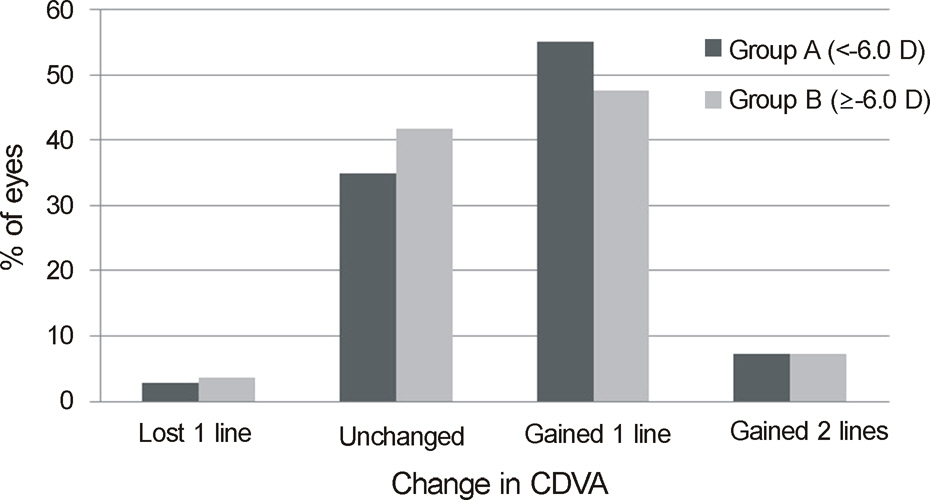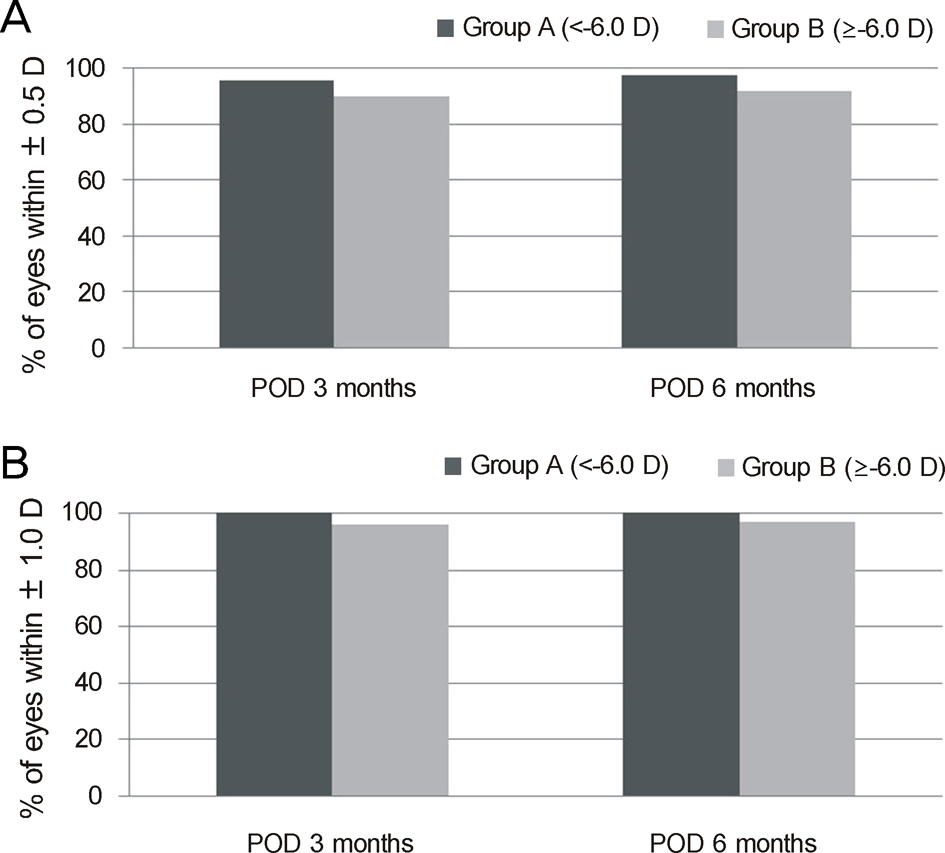J Korean Ophthalmol Soc.
2014 Jul;55(7):963-968.
Outcomes of Small Incision Lenticule Extraction: Mild to Moderate Myopia versus High Myopia
- Affiliations
-
- 1Department of Ophthalmology and Visual Science, The Catholic University of Korea College of Medicine, Seoul, Korea.
- 2Onnuri Eye Clinic, Jeonju, Korea. eyegreen@eyegreen.com
Abstract
- PURPOSE
To evaluate the refractive outcomes of small incision lenticule extraction (SMILE) in high myopia patients compared with mild to moderate myopia patients.
METHODS
This study included 332 eyes of 166 myopic patients treated with SMILE using Visumax 500 kHz femtosecond laser. Treated eyes were divided into 2 groups according to preoperative spherical equivalent (SE): mild to moderate myopia (A group, <-6.0 D) and high myopia (B group, > or =-6.0 D). Follow-up visits were at 1 day, 1 week, 1 month, 3 months, and 6 months. The outcome measures included uncorrected distance visual acuity (UDVA), best corrected distance visual acuity (BDVA), postoperative SE, efficacy index, safety index and predictability.
RESULTS
Preoperative SE was -4.85 +/- 0.86 D in the A group and -7.70 +/- 1.0 D in the B group. No differences were observed between -0.04 +/- 0.29 D in the A group and -0.30 +/- 0.37 D in the B group at 6 months postoperatively (p = 0.062). At 6 months postoperatively, 98.3% and 97.3% had UDVA of 20/25 or better in the A group and B group, respectively. In the A group, 97.3% and 100% were within +/-0.5 D and +/-1.0 D of intended correction and in the B group, 91.7% and 96.9% were within +/-0.5 D and +/-1.0 D, respectively. Efficacy indices were 1.02 +/- 0.19 in the A group and 0.99 +/- 0.18 in the B group. Safety indices were 1.16 +/- 0.16 in the A group and 1.14 +/- 0.16 in the B group. The efficacy and safety indices were not significantly different between the A and B groups at 6 months postoperatively (p = 0.09, p = 0.695, respectively).
CONCLUSIONS
This study showed that SMILE is effective and safe for correcting high myopia as well as mild to moderate myopia.
Keyword
Figure
Reference
-
References
1. Sandoval HP, de Castro LE, Vroman DT, Solomon KD. Refractive Surgery Survey 2004. J Cataract Refract Surg. 2005; 31:221–33.
Article2. Shtein RM. Post-LASIK dry eye. Expert Rev Ophthalmol. 2011; 6:575–82.
Article3. Mohammadpour M, Jabbarvand M. Risk factors for ectasia after LASIK. J Cataract Refract Surg. 2008; 34:1056.
Article4. Kim HJ, Cho SH, Kim JH, Joo CK. Risk factors and clinical evalu-ation for corneal ectasia after LASIK. J Korean Ophthalmol. 2005; 46:589–96.5. Khoueir Z, Haddad NM, Saad A, et al. Traumatic flap dislocation 10 years after LASIK. Case report and literature review. J Fr Ophtalmol. 2013; 36:82–6.
Article6. Reinstein DZ, Archer TJ, Randleman JB. Mathematical model to compare the relative tensile strength of the cornea after PRK, LASIK, and small incision lenticule extraction. J Refract Surg. 2013; 29:454–60.
Article7. Li M, Zhao J, Shen Y, et al. Comparison of dry eye and corneal sensitivity between small incision lenticule extraction and femtosecond LASIK for myopia. PLoS One. 2013; 8:e77797.
Article8. Shah R, Shah S, Sengupta S. Results of small incision lenticule extraction: All-in-one femtosecond laser refractive surgery. J Cataract Refract Surg. 2011; 37:127–37.
Article9. Hjortdal JO, Vestergaard AH, Ivarsen A, et al. Predictors for the outcome of small-incision lenticule extraction for Myopia. J Refract Surg. 2012; 28:865–71.
Article10. Sekundo W, Kunert KS, Blum M. Small incision corneal refractive surgery using the small incision lenticule extraction (SMILE) procedure for the correction of myopia and myopic astigmatism: results of a 6 month prospective study. Br J of Ophthalmol. 2011; 95:335–9.
Article11. Kamiya K, Shimizu K, Igarashi A, Kobashi H. Visual and refractive outcomes of femtosecond lenticule extraction and small-incision lenticule extraction for myopia. Am J Ophthalmol. 2014; 157:128–34.e2.12. Vestergaard A, Ivarsen AR, Asp S, Hjortdal JO. Small-incision lenticule extraction for moderate to high myopia: Predictability, safety, and patient satisfaction. J Cataract Refract Surg. 2012; 38:2003–10.
Article13. Li M, Niu L, Qin B, et al. Confocal comparison of corneal reinnervation after small incision lenticule extraction (SMILE) and femtosecond laser in situ keratomileusis (FS-LASIK). PLoS One. 2013; 8:e81435.
Article14. Ang M, Chaurasia SS, Angunawela RI, et al. Femtosecond lenticule extraction (FLEx): clinical results, interface evaluation, and intraocular pressure variation. Invest Ophthalmol Vis Sci. 2012; 53:1414–21.
Article15. Ivarsen A, Asp S, Hjortdal J. Safety and complications of more than 1500 small-incision lenticule extraction procedures. Ophthalmology. 2014; 121:822–8.
- Full Text Links
- Actions
-
Cited
- CITED
-
- Close
- Share
- Similar articles
-
- Short-term Clinical Outcomes of Small Incision Lenticule Extraction for Correction of Myopia Patients with Corneal Opacity
- Clear lens Extraction and Epikeratophakic Lenticule Removal in Complicated Epikeratophakic Patients
- Clinical Outcomes of Small Incision Lenticule Extraction in Myopia: Study of Vector Parameters and Corneal Aberrations
- Excimer laser Radial Keratotomy for Correction of Myopia and Astigmatism: Preliminary Report
- A Prospective Clinical Study of Radial Keratotomy: Report 3




